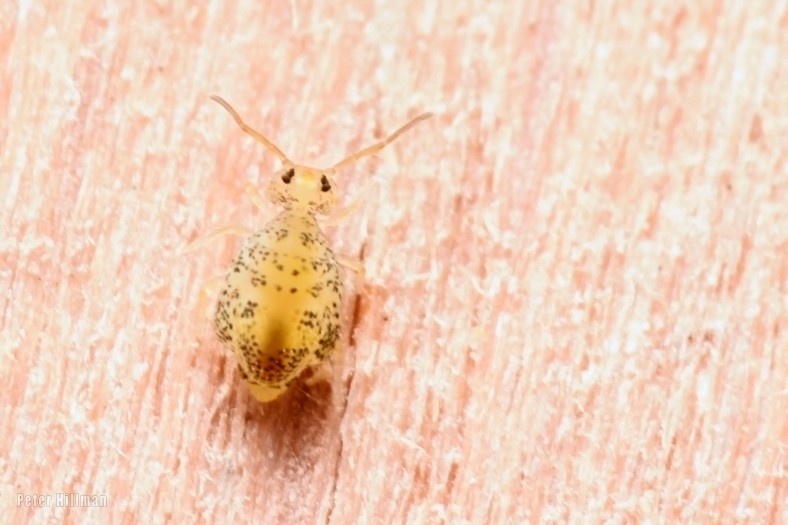
You may be wondering what an earth this blog title means? Well, coincidently for me, this is another of those species which has yet to be given a proper name!

This is a globular springtail of around 1.5-2 mm (around 5/64 in). It has to be the prettiest and perhaps the cutest I have seen, and has now become my favourite.

It is believed to have been imported from Australasia and associated with the horticultural trade. That is all the information I have been able to gain so far regarding its origin. There is no knowing its status here in the UK, either.

It appears to be fairly variable, and is seen in gardens and parks, and probably allotments and garden centres. I believe the bottom image may be a juvenile as it was smaller than the individuals above.

Amazing animal, hope you will find an answer.
LikeLiked by 1 person
Thank you, Hans 🙂
LikeLike
Brilliant macros Pete.
LikeLiked by 1 person
Thank you, Brian 🙂 They can be tricky little devils as they hardly stop moving and because of their small size. Even with the 105 macro lens and the Raynox adapter clipped on the end I have still had to crop to get closer, but glas they came out as well as they did 🙂
LikeLiked by 1 person
Yes, yes yes indeed it’s so cute and so lovely. 💞
LikeLiked by 1 person
Thank you very much 🙂
LikeLike
It is a cute one. Very nice, Pete
LikeLiked by 1 person
Thank you, Belinda 🙂
LikeLiked by 1 person
Cute as a bug certainly fits this one. It takes a special guy to have a favorite springtail, Pete. 🙂
LikeLiked by 1 person
Thank you, Steve. I have always had a thing for these globular springtails since discovering my first one some years ago. They are almost like cartoon characters. 🙂
LikeLiked by 1 person
They are rather winsome. 🙂
LikeLiked by 1 person
They are, thank you, Eliza 🙂
LikeLike
Cute little guy!! 💜😊
LikeLiked by 1 person
Thank you, Lisa 🙂 They always appear to have a smile 🙂
LikeLiked by 1 person
I notice the one you thought might be a juvenile doesn’t have any spots. Could that be another identifying mark for the young’uns? Maybe they don’t get their spots until they mature.
LikeLiked by 1 person
I might be wrong, of course, as there is very little information on these collembola to be found at present, but because they were within the same group and they have those faint speckles on the flanks, they may well be related.
LikeLike
Well, you certainly DO get down to the nitty gritty – was this one on/in your garden shed too? Having looked at these photographs a few times, I get the impression that they have an interesting character: the first one looks as though it is about to enjoy a belly-laugh at the photographer!
LikeLiked by 1 person
They always look like they are either smiling or want to have a laugh 🙂
LikeLiked by 1 person
The cutest little insect I’ve ever seen! Great pictures!
LikeLiked by 1 person
Thank you, Anki 🙂
LikeLiked by 1 person
I still have yet to see a springtail (I think)–I realize that I must look harder into the micro world.
LikeLiked by 1 person
They are around in very high numbers but seldom seen because of their size and where they hide. Most are only a couple of mm long, yet they can have so much beautiful colour and pattern. Lifing loose bark, rocks, looking closely at fallen leaves or plant vegetation with a mind to focus the eye on moving dots or something out-of-the-ordinary helps a little 🙂
LikeLiked by 1 person
That little bug has to be one of the cutest I’ve ever seen. The head and face resemble an impish little toddler just out to explore its surroundings. How could one not fall in love with the tiny insect in the last image.
Definitely smiling.
LikeLiked by 1 person
Thank you very much, Vicki 🙂 They are the cutest of the cute of bugs 😉
LikeLiked by 1 person
Terrific macro images of this bug, Pete!
LikeLiked by 1 person
Thank you, Indira 🙂
LikeLike
Wow! Brilliant capture and it’s really very cute!
LikeLiked by 1 person
Thank you! 🙂
LikeLiked by 1 person
Pete these are exceptional captures of such a sweet find! What a personality this little one has! Take good care Pete.
LikeLiked by 1 person
Thank you, Sandra! 🙂 Take care there, too!
LikeLiked by 1 person
A testimony to your sharp eyes
LikeLiked by 1 person
Thank you, Cathy 🙂
LikeLike
What a colourful beauty! Such a happy little creature, I love it 🙂
LikeLiked by 1 person
Thank you! 🙂 I am pleased you like it so!
LikeLiked by 1 person
Always interesting to find something new and then having to find out what it actually is 🙂
Thomas
LikeLiked by 1 person
It sure is 🙂
LikeLike